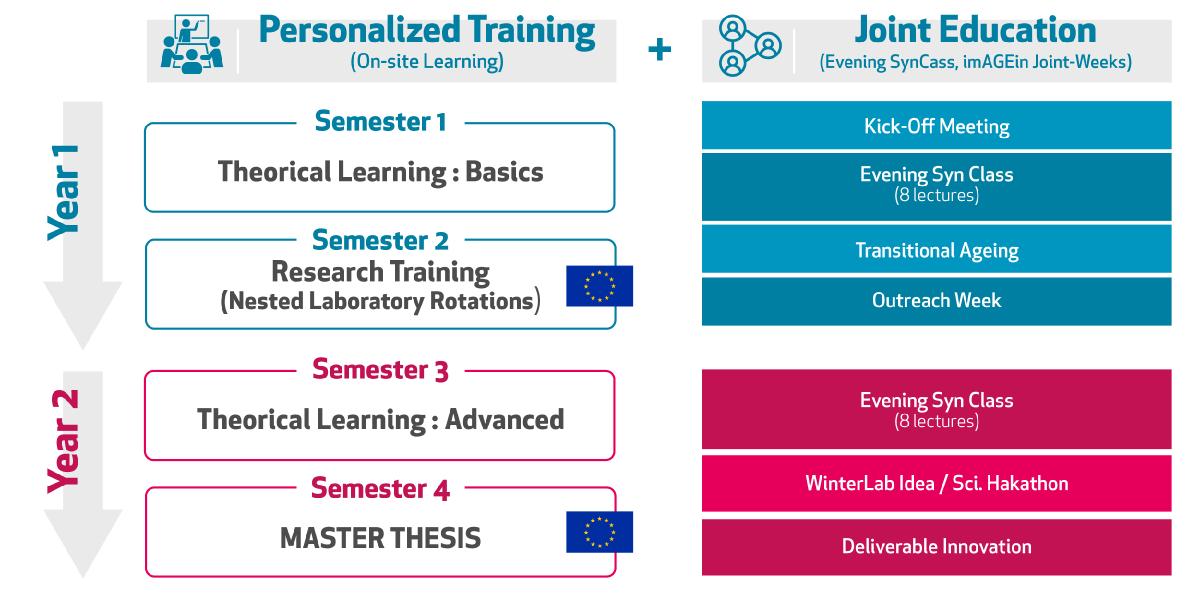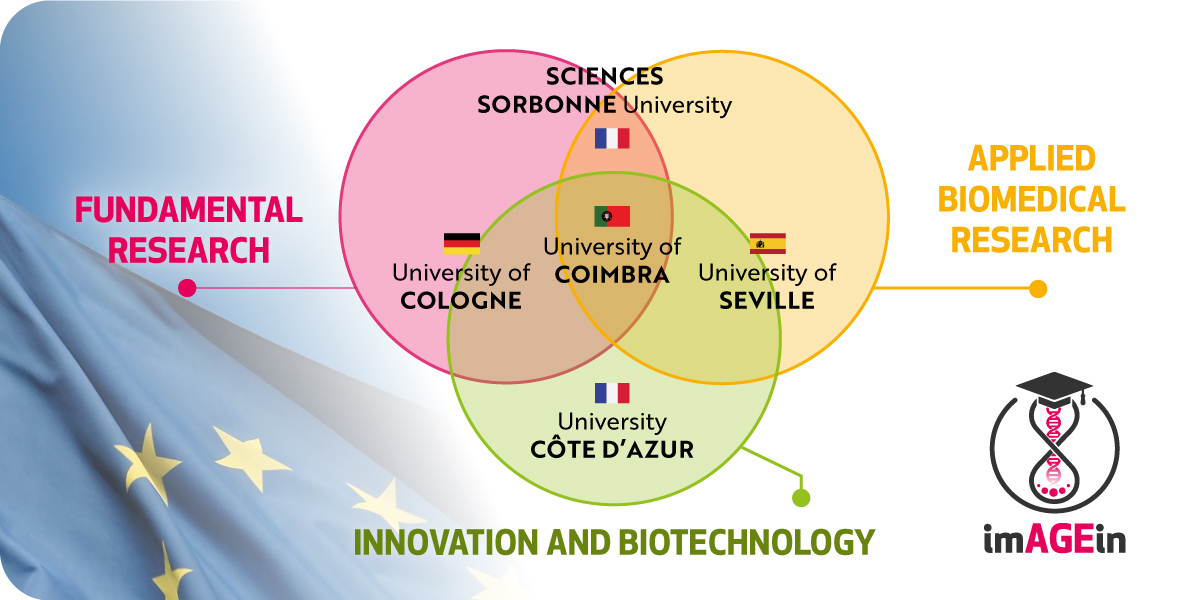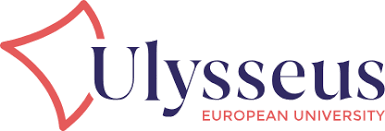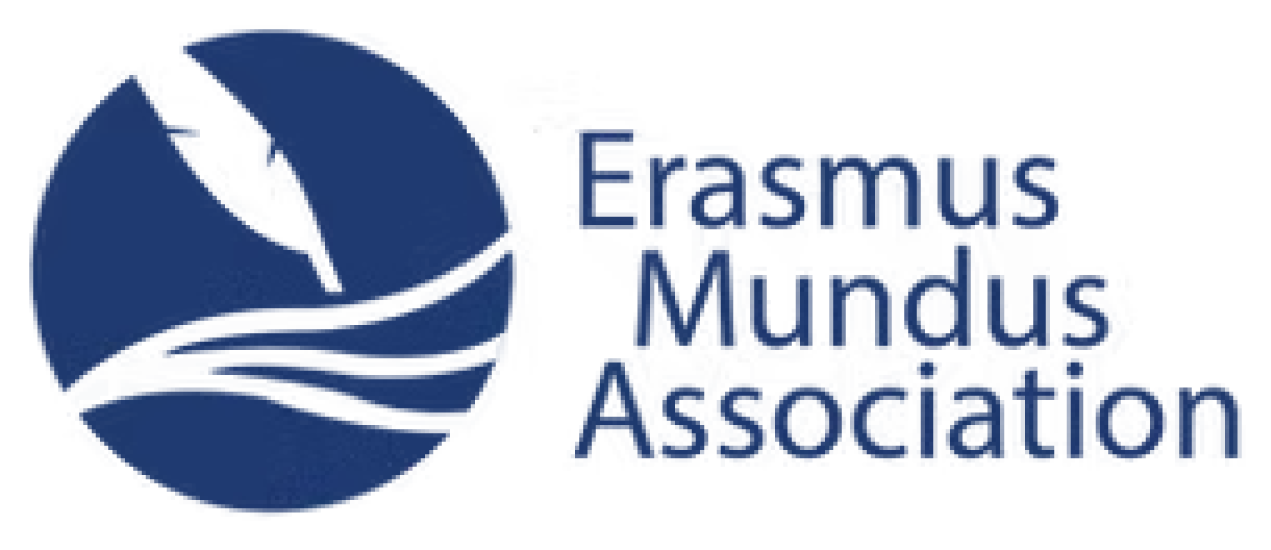
An innovative two-years joint Master programme
imAGEin programme is designed to achieve the ambitious vision of an innovative, inclusive and globally competitive and attractive two-years joint Master programme to generate added value to knowledge and research, by delivering innovation with societal impact, and therefore contribute to tackle the health negative consequences associated to the European demographic change towards an increasing share of aged population.
- The first-year compulsory pedagogic offer was defined as a broad knowledge base on the Biology of Ageing, while offering specific local expertise.
- The second year reflects even more the specialization strengths of each imAGEin partner with important investment into fundamental or applied research projects through the Master Thesis internship.
Details on each year semester curriculum and modules mutualized in imAGEin at each partner are provided on the Syllabus page.
All imAGEin curricula include one compulsory physical mobility between two countries, different from the student’s country of residence, where at least one semester corresponding to 30 ECTS needs to be validated. imAGEin mobility program will therefore be structured into two blocks of one year each.
General Structure
imAGEin contemplates Joint activities, in order to develop a common backbone through joint education. The aim is to enrich the imAGEin Joint Programme with state-of-the-art research within all Partners, outreach activities and translational knowledge.
Joint activities will also promote team building, notably by trust and understanding between imAGEin students and partners' staff. The Consortium defined two types of joint meetings: regular synchronous online classes (Evening SynClass) and punctual presential weeks (imAGEin joint-Weeks).
Figure – imAGEin general structure
Organization of study periods within the Consortium
- imAGEin mobility programme will therefore be structured into different track possibilities, each one with two blocks of one year.
- At least two HEIs welcoming a student for a semester or more must be in different countries from the country of residence of that student at enrolment stage.
- In each HEI the student will have access to the compulsory and optional modules she/he is expected to attend to obtain the ECTS (European Credit Transfer and accumulation System) required to validate the semester.
- The student will therefore be registered in these HEIs and obtain the respective local Master certificates upon successful completion of their imAGEin curriculum.
Additionally, via the Multidisciplinary Institute of Ageing (MIA, Portugal), a teaming partnership between the University of Coimbra (UC), and the University of Newcastle (UNEW) plus the University Medical Center Groningen (UMCG), externalization of students to these other sites will thus be a possibility. This type of rotation allows students to gain abroad overview of a particular research line in the biology of ageing field, as well as giving them the opportunity to specialize in a particular area in the 4th semester without being limited to the HEIs they chose in their second year.
Axis Complementarity

Figure – Consortium axis complementarity
imAGEin Learning Objectives
- Foundational knowledge in ageing biology: develop a robust understanding of the biological mechanisms of ageing, including hallmarks of ageing, model organism , regenerative processes and genetic dynamics associated to ageing.
- Interdisciplinary integration: synthesize knowledge from various disciplines such as molecular genetics and cellular signaling mechanisms, gene-programming directed therapies, tissue dynamics, stem cells, regenerative medicine, immunology, nutrition, neuroscience, homeostasis regulation, environmental stressors, age-related pathologies, geroscience, digital technologies as big data, artificial intelligences and Omics analysis, to form a holistic and interdisciplinary understanding of ageing.
- Specialization exploration: identify and engage with different specializations within ageing research, enabling the selection of a focus area that aligns with personal interests and career goals, within a research laboratory or corporate environment.
- Research methodology and design: gain proficiency in designing and conducting research experiments, from hypothesis formation to data analysis and interpretation, within the field of ageing biology.
- Develop critical thinking: by using rationality to determine what to do or believe in a specific situation. A critical thinker logically connects ideas, scrutinizes and evaluates arguments, finds inconsistencies and errors in his or her work, which allow to improve and engage in reflection.
- Innovation in Ageing Research: Foster innovative thinking to address current challenges in ageing biology, with the ability to develop novel research questions and experimental approaches.
- Entrepreneurial skills for science valorization: acquire entrepreneurial skills geared towards recognizing the value of scientific research and how it can be translated to address societal needs. E.g. intellectual property management, business planning, and start-up creation.
- Effective communication: develop strong communication skills and learn how to effectively communicate complex scientific concepts to diverse audiences, including writing scientific papers, presenting at conferences, and engaging with non-specialist stakeholders.
- Cultural competence and global perspective: build cultural competence through international experiences, understanding the global impact of ageing and the cultural and scientific factors that influence ageing populations.
- Ethical and social implications: understand the ethical, legal, and social implications of ageing research and interventions, ensuring responsible and sustainable scientific practices.
- Professional networking: cultivate a professional network by collaborating with peers, researchers, and professionals across different countries and specialties within the ageing sector.
- Career flexibility and preparedness: prepare for various career paths in academia, industry, or policy by developing transferable skills such as critical thinking, problem-solving, leadership, and management.



